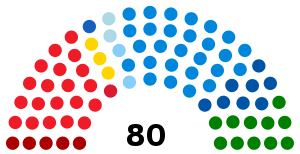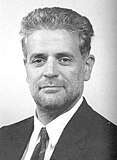2000 Lombard regional election
The Lombard regional election of 2000 took place on 16 April 2000. The 7th term of the Regional Council was chosen.
| |||||||||||||||||||||||||||||||
All 80 seats to the Regional Council of Lombardy | |||||||||||||||||||||||||||||||
|---|---|---|---|---|---|---|---|---|---|---|---|---|---|---|---|---|---|---|---|---|---|---|---|---|---|---|---|---|---|---|---|
| Turnout | 75.59% ( | ||||||||||||||||||||||||||||||
| |||||||||||||||||||||||||||||||
| |||||||||||||||||||||||||||||||
 |
|---|
| This article is part of a series on the politics and government of Lombardy |
|
Roberto Formigoni (Forza Italia) was re-elected for the second time in a row President, defeating Mino Martinazzoli (Italian People's Party). His re-election resulted in a landslide, as this time he was supported also by the Northern League.
Electoral law
Lombardy uses national Tatarella Law of 1995 to elect its Council. Sixty-four councillors are elected in provincial constituencies by proportional representation using the largest remainder method with a Droop quota and open lists; remained seats and votes are grouped at regional level where a Hare quota is used, and then distributed to provincial party lists.
Sixteen councillors are elected at-large using a general ticket: parties are grouped in alliances, and the alliance which receives a plurality of votes elects all its candidates, its leader becoming the President of Lombardy. If a coalition wins more than 50% of the total seats in the Council with PR, only 8 candidates from the regional list will be chosen and the number of those elected in provincial constituencies will be 72; if the winning alliance receives less than 50% of votes, special seats are added to the Council to ensure a large majority for the President's coalition.
Council apportionment
According to the official 1991 Italian census, the 64 Council seats which must be covered by proportional representation were so distributed between Lombard provinces.
| BG | BS | CO | CR | LC | LO | MN | MI | PV | SO | VA | total |
|---|---|---|---|---|---|---|---|---|---|---|---|
| 7 | 8 | 4 | 2 | 2 | 1 | 3 | 27 | 3 | 1 | 6 | 64 |
The allocation is not fixed. Remaining seats and votes after proportional distribution, are all grouped at regional level and divided by party lists. The consequent division of these seats at provincial level usually change the original apportionment. Only 43 seats were directly assigned at provincial level, and the final distribution between provinces changed in this way.
| BG | BS | CO | CR | LC | LO | MN | MI | PV | SO | VA | total |
|---|---|---|---|---|---|---|---|---|---|---|---|
| +2 | = | = | = | +1 | +1 | -1 | +2 | -1 | +1 | +2 | +7 |
As it can be seen, the landslide victory of the House of Freedoms caused the distribution of seven more seats to the oppositions at provincial level. Bergamo and Varese received two new seats, Cremona and Lodi and Sondrio one each.
Results
The 1999 European election marked a turning point in relations between Forza Italia and the Northern League. Silvio Berlusconi's attempt to destroy the League by a media campaign aimed at shifting protesting votes to the Italian Radicals, succeeded only in part: the consensus of the federalist movement had fallen so sharply, but not enough to ensure the coalition of the Knight from possible disasters like the 1996 election. In addition, the assembly works in parliament had highlighted a growing programmatic convergence between the two major Lombard parties. And so, in view of the 2001 general election, Berlusconi and Umberto Bossi put aside the old, and even bloody quarrels, and formed a new coalition: the House of Freedoms, which found in the regional elections its first test.
The combination of what were the major forces of regional politics, securing a safe and agile reappointment to the Communion and Liberation's incumbent President, Roberto Formigoni, which ensured stability of the Regional Cabinet that the new regulations wanted to coincide in term with the legislature. Forza Italia was confirmed as the largest party in the region with an historic 34% of the vote, while Lega Nord was the second largest party with 15%. The Olive Tree, an alliance comprising several centre-left parties including the Italian People's Party, the Democrats of the Left, The Democrats, the Federation of the Greens and Italian Renewal, which here run in a single list for the first time in Italian history, had a great shock losing a fifth of its votes, falling at only 20%.
 | |||||||||
| Candidates | Votes | % | Seats | Parties | Votes | % | Seat | ||
|---|---|---|---|---|---|---|---|---|---|
| Roberto Formigoni | 3,355,803 | 62.37 | 8 | ||||||
| Forza Italia | 1,539,359 | 33.79 | 24 | ||||||
| Northern League – Lombard League | 702,479 | 15.42 | 10 | ||||||
| National Alliance | 441,087 | 9.68 | 6 | ||||||
| United Christian Democrats | 111,112 | 2.44 | 1 | ||||||
| Christian Democratic Centre | 76,423 | 1.68 | 1 | ||||||
| Pensioners' Party | 71,925 | 1.58 | 1 | ||||||
| Socialist Party | 31,178 | 0.68 | – | ||||||
| The Liberals–Sgarbi | 21,876 | 0.48 | – | ||||||
| Total | 2,995,439 | 65.75 | 43 | ||||||
| Mino Martinazzoli | 1,692,474 | 31.46 | 1 | ||||||
| The Olive Tree | 918,345 | 20.16 | 19 | ||||||
| Communist Refoundation Party | 289,572 | 6.36 | 5 | ||||||
| SDI–FdL–Others | 86,517 | 1.90 | 1 | ||||||
| Total | 1,294,434 | 28.41 | 25 | ||||||
| Benedetto Della Vedova | 178,406 | 3.32 | – | Bonino List | 154,396 | 3.39 | 3 | ||
| Nerio Nesi | 110,202 | 2.05 | – | Party of Italian Communists | 86,027 | 1.89 | – | ||
| Giorgio Schultze | 43,696 | 0.81 | – | Humanist Party | 25,350 | 0.56 | – | ||
| Total candidates | 5,380,581 | 100.00 | 9 | Total parties | 4,555,646 | 100.00 | 71 | ||
| Source: Ministry of the Interior – Historical Archive of Elections | |||||||||
Results by province

| Province | Roberto Formigoni | Mino Martinazzoli | Benedetto Della Vedova | Turnout |
|---|---|---|---|---|
| Milan | 1,311,057 (60.01%) | 724,518 (33.16%) | 75,064 (3.44%) |
73.38% |
| Brescia | 410,929 (62.24%) | 220,489 (33.39%) | 16,039 (2.43%) |
78.34% |
| Bergamo | 400,883 (67.94%) | 159,419 (27.02%) | 16,367 (2.77%) |
79.15% |
| Varese | 319,092 (67.06%) | 124,027 (26.07%) | 18,742 (3.94%) |
74.05% |
| Como | 226,699 (69.81%) | 81,712 (25.16%) |
11,721 (3.61%) |
75.71% |
| Pavia | 188,138 (62.02%) | 92,449 (30.48%) |
11,997 (3.96%) |
77.28% |
| Mantua | 121,621 (53.08%) | 88,549 (38.65%) |
8,202 (3.58%) |
77.40% |
| Cremona | 123,317 (59.72%) |
70,621 (34.20%) |
5,667 (2.74%) |
79.51% |
| Lecco | 117,140 (62.06%) | 62,995 (33.37%) |
6,004 (3.18%) |
78.66% |
| Lodi | 68,245 (58.21%) |
41,716 (35.58%) |
3,778 (3.22%) |
78.38% |
| Sondrio | 68,682 (68.44%) |
25,979 (25.89%) |
4,825 (4.81%) |
69.26% |
Results by capital city
| City | Roberto Formigoni | Mino Martinazzoli | Benedetto Della Vedova | Turnout |
|---|---|---|---|---|
| Milan | 435,304 (59.83%) |
244,591 (33.62%) |
26,177 (3.60%) |
68.80% |
| Brescia | 67,017 (57.09%) |
44,515 (37.92%) |
3,337 (2.88%) |
76.65% |
| Bergamo | 45,064 (62.11%) |
23,506 (32.40%) |
2,374 (3.27%) |
77.10% |
| Como | 33,466 (66.37%) |
13,798 (27.37%) |
2,222 (4.41%) |
72.76% |
| Varese | 31,297 (66.37%) |
12,602 (26.73%) |
1,988 (4.22%) |
69.82% |
| Pavia | 27,578 (59.69%) |
15,281 (33.07%) |
1,809 (3.92%) |
79.16% |
| Cremona | 24,833 (55.20%) |
17,015 (37.82%) |
1,447 (3.22%) |
77.78% |
| Mantua | 14,621 (47.96%) |
13,077 (42.90%) |
1,312 (4.30%) |
76.66% |
| Lecco | 16,800 (60.36%) |
9,846 (35.37%) |
808 (2.90%) |
75.95% |
| Lodi | 15,151 (58.98%) |
8,980 (34.96%) |
836 (3.25%) |
77.73% |
| Sondrio | 7,827 (61.26%) |
4,169 (32.63%) |
645 (5.05%) |
69.49% |
References
- The swing comes from the combined result of the Pole of Freedoms (41.6%) and Lega Nord (17.7%) in the 1995 regional election.

